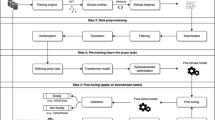Abstract
Changes in software source codes are inevitable. The source codes of software are frequently changed to meet the user’s enormous requirements. These changes are occurring due to bug repairs (BR), enhancement/modification (EM) and the addition of new features (NF). The maintenance task becomes quite difficult if these changes are not properly recorded. The versions of these frequent changes are being maintained using the software configuration management repository. These continuous changes in the software source code make the code complex and negatively affect the quality of the product. In the literature, the complexity of the code changes has been quantified using entropy based measures (Hassan, in: Proceedings of the 31st international conference on software engineering, pp. 78–88, 2009). In this paper, we have proposed a model to predict the potential complexity of code changes using entropy based measures. The predicted potential complexity of code changes helps in determining the remaining code changes yet to be diffused in the software. The proposed model has been validated using seven components of web browser Mozilla. The model has been evaluated using goodness of fit criteria namely R squared, bias, mean squared error, variation, and root mean squared prediction error (RMSPE).The statistical significance of the proposed model has been tested using χ2 and Kolmogorov–Smirnov (K–S) test. The proposed model is found statistically significant based on the associated p value of the K–S test. Further, we conclude that the rate of complexity diffusion due to BR is found higher in four cases namely Bonsai, Mozbot, tables and XUL. The other components of Mozilla namely AUS, MXR and Tinderbox show increase in complexity due to EM and NF.





Similar content being viewed by others
References
Albrecht AJ, Gaffney JR (1983) Software function, source lines of code and development effort prediction: a software science validation. IEEE Trans Soft Eng 9(6):639–648
Baisli VR (1980) Qualitative software complexity models: a summary. In: Tutorial on models and methods for software management and engineering. IEEE Computer Society Press, Los Alamitos
Bass F (1969) A new product growth model for consumer durables. Manag Sci 15(5):215–227
Canfora G, Cerulo L, Di Penta M, Pacilio F (2010) An exploratory study of factors influencing change entropy. In: The 18th IEEE international conference on program comprehension, ICPC 2010, Braga, Minho, Portugal, 30 June–2 July 2010. IEEE Computer Society, Washington, DC, pp. 134–143
Chidamber AJ, Kemerer CF (1994) A metric suite for object oriented design. IEEE Trans Soft Eng 20(6):476–493
D’Ambros M, Lanza M, Robbes R (2010). An extensive comparison of bug prediction approaches. In: Proceedings of the seventh IEEE working conference on mining software repositories (MSR07). IEEE CS Press, pp. 31–41
D’Ambros M, Lanza M, Robbes R (2012) Evaluating defect prediction approaches: a benchmark and an extensive comparison. Empir Softw Eng 17(4–5):531–577
Erlikh L (2000) Leveraging legacy system dollars for E-business. (IEEE) IT Pro, May/June 2000, pp 17–23
Halstead MH (1977) Elements of software science. Elsevier North Holland, New York
Hassan AE (2009) Predicting faults based on complexity of code change. In: proceedings of the 31st international conference on software engineering, pp 78–88
Jacobson I, Christerson M, Jonsson P, Overgaard G (1992) Object oriented software engineering: a use case driven approach. ACM Press, Addison Wesley, New York, Reading, pp 69–70
Kagdi H (2007) Improving change prediction with fine-grained source code mining. In: Proceedings of the twenty-second IEEE/ACM international conference on automated software engineering, Atlanta, Georgia, USA, 05–09 November 2007
Kagdi H, Maletic JI (2006) Software-change prediction: estimated+actual. In: SOFTWARE-EVOLVABILITY ‘06 proceedings of the second international IEEE workshop on software evolvability. IEEE Computer Society, Washington, DC, pp 38–43
Kagdi H, Maletic JI (2007) Combining single-version and evolutionary dependencies for software-change prediction. In: Proceedings of the fourth international workshop on mining software repositories held during 20–26 May 2007
McCabe TH (1976) A complexity measure. IEEE Trans Soft Eng 2(6):308–320
Mockus A, Eick SG, Graves TL, Karr AF (1999) On measurement and analysis of software changes. Technical report, National Institute of Statistical Sciences
Rochkind MJ (1975) The source code control system. IEEE Trans Soft Eng 1(4):364–370
Shannon CE (1948) A mathematical theory of communication. Bell Syst Tech J 27(379–423):623–656
The bugZilla project (2012). http://www.bugzilla.org. Accessed 30 Nov 2012
The Mozilla project (2012). http://www.mozilla.org. Accessed 30 Nov 2012
Author information
Authors and Affiliations
Corresponding author
Rights and permissions
About this article
Cite this article
Chaturvedi, K.K., Kapur, P.K., Anand, S. et al. Predicting the complexity of code changes using entropy based measures. Int J Syst Assur Eng Manag 5, 155–164 (2014). https://doi.org/10.1007/s13198-014-0226-5
Received:
Published:
Issue Date:
DOI: https://doi.org/10.1007/s13198-014-0226-5




